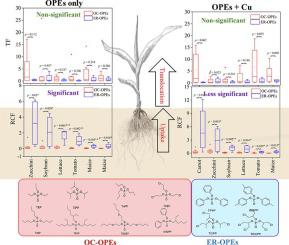Environment International ( IF 11.8 ) Pub Date : 2021-04-29 , DOI: 10.1016/j.envint.2021.106591 Beibei Hu 1 , Longfei Jiang 2 , Qian Zheng 3 , Chunling Luo 4 , Dayi Zhang 5 , Shaorui Wang 6 , Yucheng Xie 5 , Gan Zhang 2

|
Organophosphate esters (OPEs) are normally used as flame retardants, plasticizers and lubricants, but have become environmental pollutants. Because OPEs are normally present alongside heavy metals in soils, the effects of interactions between OPEs and heavy metals on plant uptake of OPEs need to be determined. In this study, we investigated the effects of OPEs chemical structure, plant cultivar and copper (Cu) on the uptake and translocation of OPEs by plants. The bioaccumulation of OPEs varied among plant cultivars. They were preferentially enriched in carrot, with the lowest concentrations observed in maize. OPEs with electron-ring substituents (ER-OPEs) exhibited a higher potential for root uptake than did OPEs with open-chain substituents (OC-OPEs), which could be attributed to the higher sorption of ER-OPEs onto root charged surfaces. This was explained by the stronger noncovalent interactions with the electron-rich structure of ER-OPEs. The presence of Cu slightly reduced the distinct difference in the ability of roots to take up OC-OPEs and ER-OPEs. This was explained by the interactions of Cu ions with the electron-rich structure of ER-OPEs, which suppressed the sorption of ER-OPEs on the root surface. A negative relationship between the logarithms of the translocation factor and octanol-water partition coefficient (Kow) was observed in treatments with either OPEs only or OPEs + Cu, implying the significant role of hydrophobicity in the OPEs acropetal translocation. The results will improve our understanding of the uptake and translocation of OPEs by plant cultivars as well as how the process is affected by the chemical structure of OPEs and Cu, leading to improvements in the ecological risk assessment of OPEs in the food chain.
中文翻译:

植物对有机磷酸酯的吸收和转运:化学结构、植物品种和铜的影响
有机磷酸酯 (OPE) 通常用作阻燃剂、增塑剂和润滑剂,但已成为环境污染物。因为 OPEs 通常与土壤中的重金属一起存在,所以需要确定 OPEs 和重金属之间的相互作用对植物吸收 OPEs 的影响。在这项研究中,我们研究了 OPEs 的化学结构、植物品种和铜 (Cu) 对植物吸收和转运 OPEs 的影响。OPEs 的生物积累因植物品种而异。它们优先富含胡萝卜,在玉米中观察到的浓度最低。具有电子环取代基的 OPEs (ER-OPEs) 比具有开链取代基的 OPEs (OC-OPEs) 表现出更高的根吸收潜力,这可能归因于 ER-OPEs 在根带电表面上的更高吸附。这可以通过与 ER-OPE 的富电子结构更强的非共价相互作用来解释。Cu 的存在略微降低了根吸收 OC-OPE 和 ER-OPE 能力的明显差异。这可以通过铜离子与 ER-OPEs 的富电子结构的相互作用来解释,这抑制了 ER-OPEs 在根表面的吸附。易位因子的对数与辛醇-水分配系数(K 这抑制了根表面上 ER-OPE 的吸附。易位因子的对数与辛醇-水分配系数(K 这抑制了根表面上 ER-OPE 的吸附。易位因子的对数与辛醇-水分配系数(Kow ) 在仅使用 OPEs 或 OPEs + Cu 的处理中观察到,这意味着疏水性在 OPEs 顶叶易位中的重要作用。研究结果将增进我们对植物品种对 OPE 的吸收和易位以及 OPE 和 Cu 的化学结构如何影响这一过程的理解,从而改进食物链中 OPE 的生态风险评估。



























 京公网安备 11010802027423号
京公网安备 11010802027423号